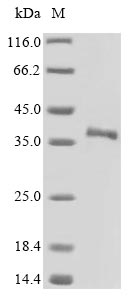The region for expressing recombinant Mouse Sfrp5 contains amino acids 22-314. The theoretical molecular weight of the Sfrp5 protein is 37.2 kDa. This protein is generated in a e.coli-based system. The Sfrp5 coding gene included the N-terminal 6xHis tag, which simplifies the detection and purification processes of the recombinant Sfrp5 protein in following stages of expression and purification.
The mouse-derived secreted frizzled-related protein 5 (Sfrp5) is a member of the SFRP family, known for modulating Wnt signaling. Sfrp5 acts as a soluble antagonist to Wnt ligands, preventing their interaction with Frizzled receptors. This interference regulates various cellular processes, including embryonic development, tissue homeostasis, and cell differentiation. In research, Sfrp5 has been implicated in adipose tissue biology and metabolic regulation. It plays a role in the regulation of adipogenesis and inflammation in adipose tissues, contributing to metabolic homeostasis. Additionally, studies explore the potential of Sfrp5 as a therapeutic target for obesity-related metabolic disorders and its involvement in insulin sensitivity.




